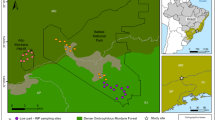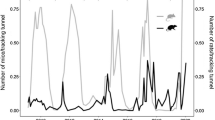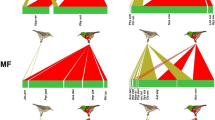Abstract
Some mammalian predators acquire both food and shelter from their prey, by eating them and using the refugia the prey construct. I searched the literature for examples of predators that exhibit this behavior and summarize their taxonomic affiliations, relative sizes, and distributions. I hypothesized that size ratios of species involved in this dynamic would be near 1.0, and that most of these interactions would occur at intermediate and high latitudes. Seventeen species of Carnivorans exploited at least 23 species of herbivores as food and for their refugia. Most of them (76.4 %) were in the Mustelidae; several small species of canids and a few herpestids were exceptions. Surprisingly, the average predator/prey weight ratio was 10.51, but few species of predators were more than ten times the weight of the prey whose refugia they exploit. This may be why the long and thin Mustelines commonly exploit this habit. A number of predators appropriate the refugia of their key prey during winter when their prey occupies thermally secure nests. Indeed, most of the predator–prey pairs that engage in this relationship occur in intermediate and high latitudes, though there may be a reporting bias. Predators that depend on prey as food and for shelter, and whose fates are linked strongly to a few key prey species, may be particularly vulnerable to changes in climate that affect the subnivean habitats of their prey. Mammals that create refugia that can be used by other species (among them predators) may play disproportionately important roles in their communities.

Similar content being viewed by others
References
Anderson MD, Richardson PRK (2005) The physical and thermal characteristics of aardwolf dens. S Afr J Wildl Res 35:147–153
Blandford PRS (1987) Biology of the polecat, Mustela putorius: a literature review. Mammal Rev 17:155–198
Bomberg (1937) Cats and ferrets in rabbit holes. Wild and Hund, Berlin 43:528 (cited in Blandford 1987)
Brom IP (1954) Materials on the biology of the transbaikal polecat. Nauchno-Issledovatel’shogo Protivo-chumnogo Instituta Sibiri i Dalnego Vostoka 12:224–230. (cited in Stroganov 1969)
Brugge T (1977) Prey selection of weasel, stoat and polecat in relation to sex and size. Lutra 19:39–49
Buskirk SW (1984) Seasonal use of resting sites by marten in south-central Alaska. J Wildl Manag 48:950–953
Campell TM, Clark TW, Richardson L, Forrest SC, Houston BR (1987) Food habits of Wyoming black-footed ferrets. Am Midl Nat 117:208–210
Clark M (1983) Mammal watching. Hamlyn, Fletham (cited in Blandford 1987).
Clark TW (1989) Conservation biology of the black-footed ferret, Mustela nigripes. Wild Preserv Trust Inter, Special Sci Rep No. 3, 175 pp
Copeland JP, Whitman JS (2003) Wolverine. In: Feldhamer GA, Thompson BC, Chapman JA (eds) Wild mammals of North America: biology, management and conservation. John Hopkins University Press, Baltimore, pp 672–682
Cypher BL (2003) Foxes: Vulpes species, Urocyon species, and Alopex lagopus. In: Feldhamer GA, Thompson BC, Chapman JA (eds) Wild mammals of North America: biology, management and conservation. John Hopkins University Press, Baltimore, pp 511–546
Dawson NG, Cook JA (2012) Behind the genes: diversification of North American martens (Martes americana and M. caurina). In: Aubry KB, Zielinski WJ, Raphael MG, Proulx G, Buskirk SW (eds) Biology and conservation of martens, sables, and fishers. Cornell University Press, Ithaca, pp 23–38
Dunwell MR, Killingley A (1969) The distribution of badger setts in relation to the geology of the Chilterns. J Zool 158:204–208
Errington PL (1961) Muskrats and marsh management. Univ. of Nebraska Press, Lincoln
Errington PL (1963) Muskrat populations. Iowa State Univ. Press, Ames
Feige N, Ehrich D, Popov IY, Broekhuizen S (2012) Monitoring least weasels after a winter peak of lemmings in Taimyr: body condition, diet and habitat use. Arctic 65:273–282
Fitzgerald BM (1977) Weasel predation on a cyclic population of the montane vole (Microtus montanus) in California. J Anim Ecol 46:367–397
Gehrt S (2003) Raccoon (Procyon lotor) and Allies. In: Feldhamer GA, Thompson BC, Chapman JA (eds) Wild mammals of North America: biology, management and conservation. John Hopkins University Press, Baltimore, pp 611–634
Gilchrist JS, Jennings AP, Veron G, Cavallini P (2009) Herpestidae (Mongooses). In: Wilson DE, Mittermeier RA (eds) Handbook of the mammals of the World, Vol. 1. Carnivores. Lynx Edicions, Barcelona, pp 262–328
Gorsuch WA, Lariviére S (2005) Vormela peregusna. Mamm Species. Am Soc Mamm Number 779, 5 pp
Heptner VG, Naumov NP (1974) The mammals of the Soviet Union. Berlin, Germany (cited in Gorsuch and Lariviére 2005)
Jaksic FM, Soriguer RC (1981) Predation upon the European rabbit (Oryctolagus cuniculus) in mediterranean habitats of Chile and Spain: a comparative analysis. J Anim Ecol 50:269–281
Jennings AP, Veron G (2009) Viverridae (Civets, Genets and Oyans). In: Wilson DE, Mittermeier RA (eds) Handbook of the mammals of the World, Vol. 1. Carnivores, Lynx Edicions, Barcelona, pp 174–232
Kilgore DL (1969) An ecological study of the swift fox (Vulpes velox) in the Oklahoma panhandle. Am Midl Nat 81:512–534
King KM, Powell RA (2007) The natural history of weasels and stoats: ecology, behavior and management, 2nd edn. Oxford University Press, Oxford
Lariviére S (2001) Poecilogale albinucha. Mamm Species. Am Soc Mamm Number 681, 4 pp
Lariviére S, Calzada J (2001) Genetta genetta. MammSpecies. Am Soc Mamm Number 680, 6 pp
Lindzey FG (2003) Badger (Taxidea taxus). In: Feldhamer GA, Thompson BC, Chapman JA (eds) Wild mammals of North America: biology, management and conservation. John Hopkins University Press, Baltimore, pp 683–691
List R, Macdonald DW (2003) Home range and habitat use of the kit fox (Vulpes macrotis) in a prairie dog (Cynomys ludovicianus) complex. J Zool 259:1–5
MacLean SF Jr, Fitzgerald BM, Pitelka FA (1974) Population cycles in Arctic lemmings: winter reproduction and predation by weasels. Arct Alp Res 6:1–12
Matthews LH (1952) British mammals. Collins, London
Morrell S (1972) Life history of the San Joaquin kit fox. Calif Fish Game 58:162–174
Murdoch JD, Munkhzul T, Buyandeler S, Reading RP, Sillero-Zubiri C (2010) Seasonal food habits of corsac and red foxes in Mongolia and the potential for competition. Mamm Biol 75:36–44
Murdoch JD, Munkhzul T, Buyandeler S, Reading RP, Sillero-Zubiri C (2013) The endangered Siberian marmot Marmota sibirica as a keystone species? Observations and implications of burrow use by corsac foxes Vulpes corsac in Mongolia. Oryx 43:431–434
Nel JAJ, Kok OB (1999) Diet and foraging group size in the yellow mongoose: a comparison with the suricate and the bat-eared fox. Ethol Ecol Evol 11:25–34
Palomares F, Delibes M (1993) Resting ecology and behaviour of Egyptian mongooses (Herpestes ichneumon) in southwestern Spain. J Zool 230:557–566
Palomares F, Gaona P, Ferreras P, Delibes M (1995) Positive effects on game species of top predators by controlling smaller predator populations: an example with lynx, mongooses, and rabbits. Conserv Biol 9:295–305
Pauli JN, Zuckerberg B, Whiteman JP, Porter W (2013) The subnivium: a deteriorating seasonal refugium. Front Ecol Environ 11:260–267
Power ME, Tilman D, Estes JA, Menge BA, Bond WJ, Mills LS, Daily G, Castilla JC, Lubchenco J, Paine RT (1996) Challenges in the quest for keystones. Bioscience 46:609–620
Pulliainen E, Ollinmäki P (1996) A long-term study of the winter food niche of the pine marten Martes martes in northern boreal Finland. Acta Theriol 41:337–352
Raine RM (1981) Winter food habits, responses to snow cover and movements of fishers (Martes pennanti) and marten (Martes americana) in southeastern Manitoba. Masters thesis, University of Manitoba, Winnipeg, 145 pp
Rasa OAE (1983) Dwarf mongoose and hornbill mutualism in the Taru Desert, Kenya. Behav Ecol Sociobiol 12:181–190
Reese EA, Standley WG, Berry WH (1992) Habitat, soils, and den use of San Joaquin kit fox (Vulpes velox macroris) at Camp Roberts Army National Guard Training site. California Rep US Dept Army and Air Force Nat Guard, EG&G Energy Measurements, Goleta
Roberts TJ (1977) The mammals of Pakistan. Ernest Benn Limited, London (cited in Gorsuch and Lariviére 2005)
Ross S, Kamnitzer R, Munkhtsog B, Harris S (2010a) Den-site selection is critical for Pallas’s cats (Otocolobus manul). Can J Zool 88:905–913
Ross S, Munkhtsog B, Harris S (2010b) Dietary composition, plasticity, and prey selection of Pallas's cats. J Mammal 91:811–817
Rowe-Rowe DT (1978) Comparative prey capture and food studies of South African mustelines. Mammalia 42:175–196
Sato JJ, Wolsan M, Prevosti FJ, D’Elía G, Begg C, Begg K, Hosoda T, Campbell KL, Suzuki H (2012) Evolutionary and biogeographic history of weasel-like carnivorans (Musteloidea). Mol Phylogenet Evol 63:745–757
Sheets RG, Linder RL, Dahlgren RB (1971) Burrow systems of prairie dogs in South Dakota. J Mammal 52(451):453
Simon TL (1980) Ecological study of the marten in the Tahoe National Forest, California. Masters thesis, California State University, Sacramento, California USA 187 pp
Smith FS, Lyons SK, Morgan Ernest SK, Jones KE, Kaufman DM, Dayan T, Marquet PA, Brown JA, Haskell JP (2003) Body mass of late quaternary mammals. Ecol Arch 84:3403
Spencer WD (1987) Seasonal rest-site preferences of pine martens in the northern Sierra Nevada. J Wildl Manag 51:616–621
Stanley WC (1963) Habits of the red fox in northeastern Kansas. Miscell Publ Univ Kansas Mus Nat Hist 34, 31 pp
Stroganov SU (1969) Carnivorous mammals of Siberia. Translated from Russian, Isreael Program for Scientific Translations, Jerusalem
Sunquiest ME, Sunquist FC (2009) Felidae (Cats). In: Wilson DE, Mittermeier RA (eds) Handbook of the mammals of the World, Vol. 1. Carnivores, Lynx Edicions, Barcelona, pp 54–169
Uresk DW, Sharps JC (1986) Denning habitat and diet of the swift fox in western South Dakota. Great Basin Nat 46:249–253
van Staaden MJ (1994) Suricata suricatta. Mamm Species. Am Soc Mamm, Number 483, 6 pp
Vorhies CT, Taylor WP (1922) Life history of the Kangaroo Rat: Dipodomys spectabilis spectabilis Merriam. No. 1091. US Department of Agriculture, 1922
Zhang Y, Zhang Z, Liu J (2003) Burrowing rodents as ecosystem engineers: the ecology and management of plateau zokors Myospalax fontanierii in alpine meadow ecosystems of the Tibetan Plateau. Mammal Rev 33:284–294
Zielinski WJ, Spencer WD, Barrett RH (1983) Relationship between food habits and activity patterns of pine martens. J Mammal 64:387–396
Zverev MD (1931) Materials on biology and agricultural importance in Siberia of the polecat and other small predators of the family Mustelidae. Proc Inst Plant Protect Siberia, Novosibirsk, Russia 1:5–48
Acknowledgments
I thank S. LaPoint, J. Lewis, and R. Green for information and conversations that contributed to the paper and R. Schlexer and M. Zielinski for editorial assistance. This work was funded by the USDA Forest Service, Pacific Southwest Research Station.
Author information
Authors and Affiliations
Corresponding author
Additional information
Communicated by: Karol Zub
Rights and permissions
About this article
Cite this article
Zielinski, W.J. When prey provide more than food: mammalian predators appropriating the refugia of their prey. Mamm Res 60, 285–292 (2015). https://doi.org/10.1007/s13364-015-0236-y
Received:
Accepted:
Published:
Issue Date:
DOI: https://doi.org/10.1007/s13364-015-0236-y




